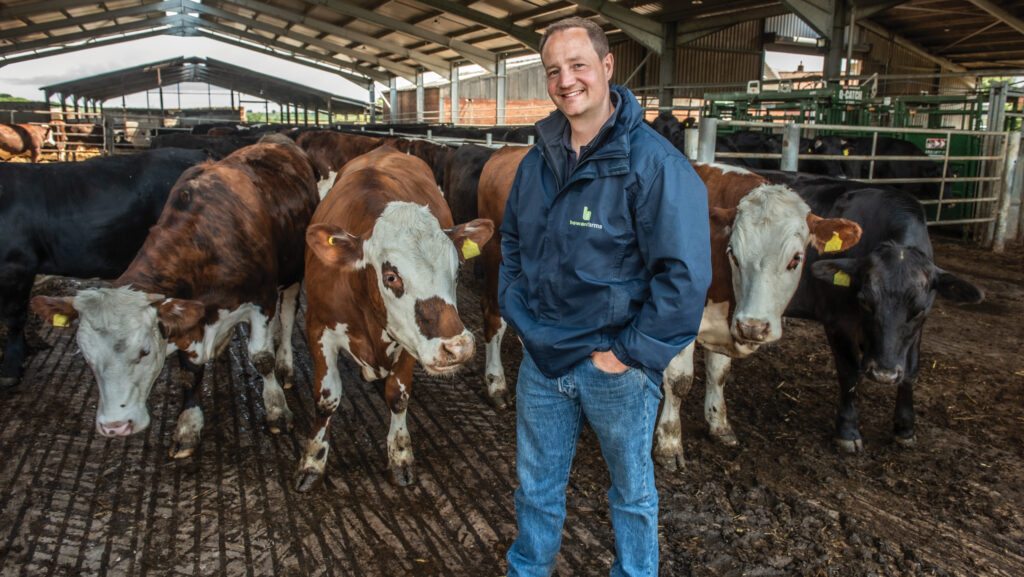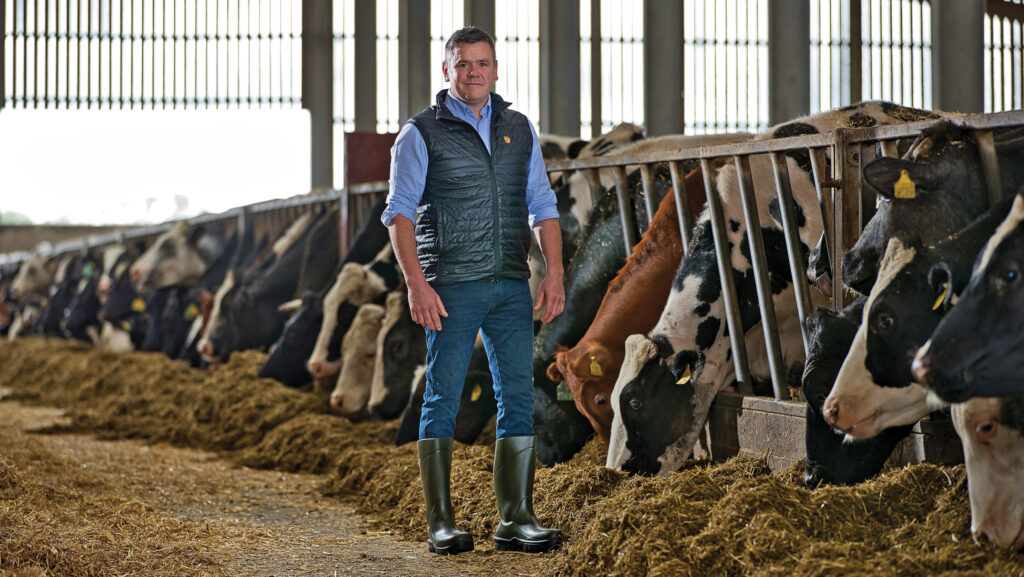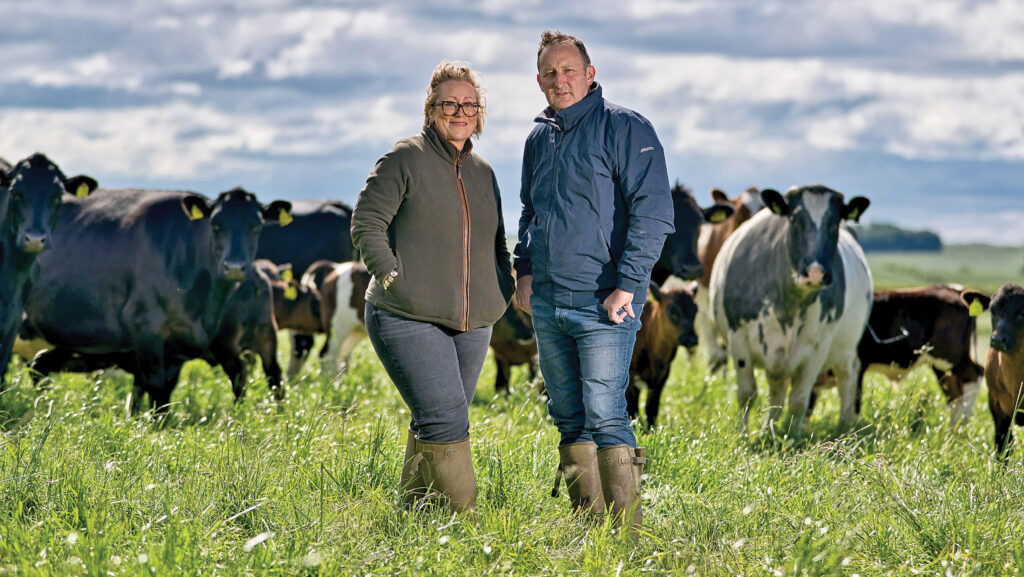Farmers Weekly Awards 2024: Beef Farmer of the Year finalists
 Beef Farmer of the Year 2024 finalists (left to right) Dan and Catherine Mercer, Dylan Jones, Joseph Howard
Beef Farmer of the Year 2024 finalists (left to right) Dan and Catherine Mercer, Dylan Jones, Joseph Howard It takes courage and vision to make radical changes to farming practices, but three beef producers have done that and built enterprises that are both profitable and environmentally responsible.
Finalists
- Joe Howard – Hodstock Lodge Farm, Nottinghamshire
- Dylan Jones – Castellior, Anglesey
- Dan and Catherine Mercer, Westhill Farm, Wiltshire
The judges
- James Hadwin – James runs his beef and sheep consultancy, JH Agri Consultancy, in Cumbria where he also farms a tenanted holding.
- Ian Farrant – Last year’s winner Ian farms in Herefordshire where he grows and fattens calves within a business that includes dairying.
- Debbie James – Debbie is Farmers Weekly’s correspondent in Wales, where she also produces milk and beef on a farm in Pembrokeshire.
Joe Howard, Hodstock Lodge Farm, Nottinghamshire

Joe Howard © Phil Weedon
That has resulted in better growth rates and average age of slaughter, and has allowed more animals to be produced in the same system.
System
Beef is produced on an outdoor forage-based system, an enterprise the Howard family run alongside their large-scale vegetable and cereal business.
It was first introduced to improve soil health. Joe took charge of that side of the business in 2016, building up suckler cow numbers to 400.
However, despite running a healthy and fertile herd, it initially struggled to make a profit.
He looked at different options, drafting in dairy cross beef calves for finishing, and they performed so well that it sealed the decision to switch entirely to dairy beef production.
Aberdeen Angus-cross and Hereford-cross calves are now sourced from spring block-calving dairy farms in Scotland, including one part-owned by the Howards.
Nutrition
The calves spend four months on rearing units close to the source farms before arriving at Hodstock Lodge where they rotationally graze herbal leys with some supplementary feed until late summer, before transitioning onto fodder beet for the winter.
Beet is undersown with chicory, which, along with winter-sowing forage rye in the grazed areas, provides a green cover to protect soil as well as a winter feed source for birds.
In late spring, 500kg animals are housed for finishing, while the smaller cattle start a second summer rotationally grazing on rented grassland.
As grass growth on that land slows, grazing demand is reduced by drafting the biggest animals into the sheds for finishing on home-grown lucerne plus maize topped up with brewers’ grains and maize meal.
Cattle finish at 22.4 months on home-grown forage and a total mixed ration of lucerne and maize – crops which suit the farm’s soil type.
Performance
Regular weighing is integral to the system, flagging up issues at an early stage.
For example, growth slowed when cattle transitioned onto fodder beet so a feed-out trailer with weigh cells was bought to allow greater accuracy with allocations.
Weighing also showed that the longer cattle stayed on beet in the spring, the better their growth rates.
As a result, the stocking rate on the crop was reduced to allow for a longer feeding period.
Joe uses a daily cost of production figure, which he calculates after each weighing to give a more instant picture rather than waiting for year-end data.
“I calculate the daily costs per head and convert this into the required growth rate per day at the current liveweight price to hit the break-even point,’’ he explains. He then works out the daily “spot margin” a head.
These figures have helped the business make the most of its better production periods, while highlighting aspects that need avoiding or improving.
The trajectory is upward, with margin a head more than doubling in 2023 compared with the previous year.
In numbers
- 1,700 – Number of cattle finished annually
- 0.88 – Daily lifetime average growth rate (kg)
- 300 – Average deadweight (kg)
- 22.4 – Finishing age (months)
Farm facts
- 468ha farmed, 283ha of which is owned
- Light sandy soils
- Majority of cattle sold to Dovecote Park and Grass Roots Farming
- 37kW roof-and field-mounted solar panels
- 50kW wind turbine
- Electronic identification for all cattle
Judges liked
- Always looking for marginal gains to improve overall performance
- Quick to analyse systems and make wholesale changes where necessary
- Integrating livestock and arable farming with mutual benefits for each enterprise
- Great relationships at both ends of the supply chain, especially with calf rearers
What the judges say
“Joe is demonstrating the positives that cattle can bring to an arable system, raising cattle profitably while still protecting and improving the environment.”
Dylan Jones – Castellior, Anglesey

Dylan Jones © Richard Stanton
Performance monitoring every animal has helped beef finisher Dylan Jones reduce days to slaughter from 127 to 99 days in a system that is completely self-sufficient in feed.
To achieve this, he has implemented a number of processes, from weighing 150 cattle every week to using technology to monitor growth rates.
The fourth-generation beef farmer and his father, Wyn, finish 1,600 cattle a year at Castellior, and are constantly looking at ways to improve efficiency and reduce the environmental impact of the farming operations.
Adopting all these processes has paid dividends as project work with Farming Connect estimates the farm’s net carbon footprint to be 3.9kg carbon dioxide equivalent/kg beef liveweight – which is considerably lower than the national average in Wales.
System
The business model of producing all feed on farm means growing crops that are high in protein and starch.
Dylan has opted for a two- to three-year rotation, growing high-protein grasses that do not rely on chemical nitrogen, and red clover, which he adds to most leys.
Such is his faith in the legume that he also undersows it in some of the barley crops.
“Red clover’s importance as a protein source has been fundamental to us optimising growth rates on home-grown feed, and species like this, with a long root system, should also increase soil carbon sequestration levels.”
Management of grassland and soil is a priority. Silaging is on a multicut system with cuts taken every six to eight weeks; the first in 2024 was taken on 18 April.
Thanks to the N-fixing properties of red clover, and the soil improvement programme, only 120kg/ha of artificial fertiliser is applied for a total of five cuts.
Nutrition
Dylan is responsible for formulating the total mixed ration (TMR).
“I can see the fruits of my labour every week when I weigh the cattle,” he says.
All field work is done in-house with no contractors used across the business – Dylan needs the best forage possible and likes to have control over that process.
By crimping, crops can be harvested up to three weeks earlier than they otherwise would be.
Performance
Dylan uses the Breedr precision livestock app to record data and to inform his decision-making on cattle sales.
This can be deciding whether to draw out cattle that have reached their full potential, or pinpointing animals with poor genetics that are not utilising the TMR and falling behind on daily liveweight gains.
He takes every opportunity to benchmark, from weighing cattle at six-weekly intervals, to seeing how they are performing in specific fields, to working out which grass varieties perform the best.
Cattle performance is monitored against genetics to ensure the animals being sourced are high-performing.
Dylan enjoys the challenges that come with running a profitable beef system in tandem with achieving his environmental goals.
Over the years he has planted hundreds of trees at Castellior through Glastir, Growing for the Environment and other schemes.
“I’m extremely focused on hitting my environmental goals, and doing so by farming,” he says.
He and his wife, Siwan, have two sons, 13-year-old Bedwyr and Gwilym, 11, who share his outlook on farming, and that is a key driver for him.
“My main goal is to create a strong agricultural foundation for them, to give both the opportunity to farm one day if they want to,” he says.
In numbers
- 150 – Number of cattle weighed weekly
- 28-30 – Finishing age in months
- 4 – Staff (two are part time)
- 120-140 – Cattle supplied monthly to ABP
Farm facts
- 324ha farmed; 243ha owned
- Loamy clay soil
- 134ha barley
- 8ha peas
- 2,000t of silage harvested annually
- Ration comprises: 7kg crimped barley, 2kg red clover silage, 2kg Westerwold silage, 5kg high-protein silage and 0.5kg straw.
Judges liked
- Incredible attention to detail throughout the business
- Making maximum use of home-produced nutrients
- Excellent use of technology and data
- Farming with 100% commitment and passion
- Exceptional crop and grass management
What the judges say
“Dylan has shown that it is not only possible for an intensive beef finisher to run a highly sustainable system, but to also do it incredibly well”
Dan and Catherine Mercer, Westhill Farm, Wiltshire

Dan (right) and Catherine Mercer © Richard Stanton
In the first year they took over the family farm, Dan and Catherine Mercer made some considerable changes, breeding their suckler herd to native sires and establishing a beef finishing unit.
A sustained period of drought the following year (2022) prompted a third significant system change when they shifted their focus to regenerative farming practices.
All this in combination has set the Mercers on the path to achieving their ambition to create a thriving and sustainable farming enterprise which, with their three children all keen to farm, can grow to accommodate that succession.
System
Beef is produced from a suckler herd of 130 cows, sired by Aberdeen Angus and Beef Shorthorn bulls.
Home-bred heifers are retained as replacements and the remaining females are fattened in the finishing unit at Westhill Farm; male progeny are either sold as stores or fattened.
A big proportion of the finishing cattle are dairy cross Angus and Herefords, which are bought at 18-22 months.
“Historically, we were [total mixed ration] feeding smaller cattle throughout the summer, but we are now focused on feeding larger fattening cattle all year round.
“The smaller cattle graze throughout the summer utilising our permanent pasture on Salisbury Plain,” explains Dan.
Nutrition
A regenerative grazing system has been established on 60ha (148 acres) for the suckler cows: they are split into four groups and moved twice a week.
This system was introduced after the 2022 drought resulted in winter stocks of silage and hay being fed throughout the summer, putting pressure on winter feed availability.
The Mercers reviewed the resilience of their system and in 2023 joined a regenerative grazing group, prompting a shift to rotational grazing.
Nitrogen use on the grazing area halved to 35kg N/ha – a saving of about £100/ha at current prices and without reducing grass growth or productivity.
All grassland is now in a low-input Countryside Stewardship option or Sustainable Farming Incentive (SFI) low-input grassland.
“Our main objective is to manage our grazing, to optimise livestock productivity, and to grow as much grass as cheaply as possible without the use of supplementary feeding during the grazing season whilst calves are at foot,” says Dan.
Performance
Weaned calves achieve an average daily liveweight gain (DLWG) of 0.7-1kg on a grower ration until turnout or sale.
Growth in the dairy beef unit cattle averages 0.6-1kg a head a day, with an average of 783 days at slaughter at a finishing deadweight of 280-300kg.
For suckler progeny, DLWG is 1-1.4kg/day, finishing at 680 days and 330kg deadweight.
At current prices, the finishing ration costs about £1.82/day, depending on how much barley is added. Increasing cattle numbers and selling 25 finishers monthly helps with cashflow.
Many of the changes have been put in place to help the business adapt to the changing climate, leaving the Mercers feeling better equipped to make decisions that will improve the resilience of their farm and business.
“Some things are inevitable, some things we have no control over, but there are things we can manage,” says Catherine.
“We feel more confident that we are able to adapt and continue to provide a solid framework for the future of our livestock business and family.”
In numbers
- 97.5 – Conception rate percentage
- 2.5 – Barren rate percentage
- 333 – Calf weaning weight (kg)
- 45.6 – Cow/calf weaning weight percentage
Farm facts
- 133ha owned plus 263ha rented
- Includes 283ha arable
- Further 60ha contract farmed
- March–May calving
- Suckled stores sold at Salisbury livestock market
- Winter cover crops grown on arable land
Judges liked
- The speed at which Dan and Catherine have changed their system, especially switching to multi-paddock grazing
- Integrating livestock into the arable system to benefit both enterprises
- Having a long-term view for staffing and succession
- Careful land stewardship
What the judges say
“The results Dan and Catherine are achieving after making major changes are testament to their focus and attention to detail, and to what can be achieved with vision and effort.”
A word from our sponsor

“We’re delighted to be sponsoring the Farmers Weekly Awards again and celebrating the high standards and innovation on show in this category. Best of luck to all the finalists.”
Richard Phelps, ABP UK Agri Director
